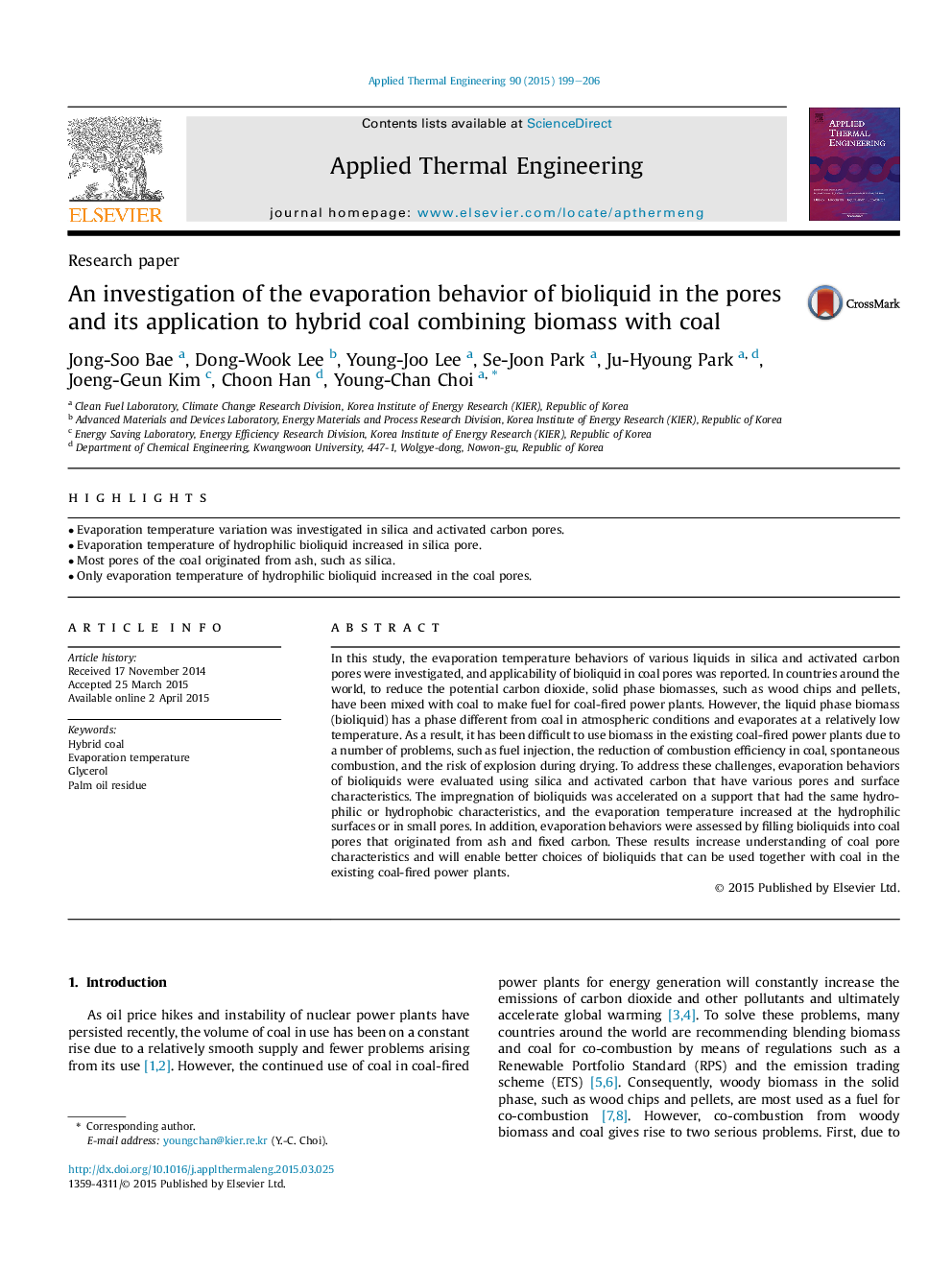| کد مقاله | کد نشریه | سال انتشار | مقاله انگلیسی | نسخه تمام متن |
|---|---|---|---|---|
| 7048826 | 1457138 | 2015 | 8 صفحه PDF | دانلود رایگان |
عنوان انگلیسی مقاله ISI
An investigation of the evaporation behavior of bioliquid in the pores and its application to hybrid coal combining biomass with coal
ترجمه فارسی عنوان
بررسی رفتار تبخیر زیستی مایع در منافذ و کاربرد آن در زغال سنگ هیبرید ترکیب زیست توده با ذغال سنگ
دانلود مقاله + سفارش ترجمه
دانلود مقاله ISI انگلیسی
رایگان برای ایرانیان
کلمات کلیدی
زغال سنگ ترکیبی دمای تبخیر، گلیسرول، باقی مانده روغن نخل،
ترجمه چکیده
در این مطالعه رفتارهای دمای تبخیری مختلف مایعات در سیلیس و منافذ کربن فعال مورد بررسی قرار گرفت و کاربرد بیولوژیکی در منافذ زغال سنگ گزارش شده است. در کشورهای سراسر جهان برای کاهش دی اکسید کربن بالقوه، زیست توده فاز جامد، مانند تراشه های چوب و گلوله ها، با زغال سنگ مخلوط شده اند تا سوخت برای نیروگاه های زغال سنگ تولید شود. با این حال، زیست توده فاز مایع (بیولوژیکی) دارای یک مرحله متفاوت از زغال سنگ در شرایط جو است و در دمای نسبتا کم تبخیر می شود. در نتیجه، استفاده از زیست توده در نیروگاه های زغال سنگ موجود به دلیل تعدادی از مشکلات، مانند تزریق سوخت، کاهش بهره وری احتراق در زغال سنگ، احیا خود به خود و خطر انفجار در طی خشک کردن، دشوار است. برای مقابله با این چالش ها، رفتار تبخیر از کمبود های بیولوژیکی با استفاده از سیلیکا و کربن فعال که منافذ و ویژگی های سطحی مختلف دارند، مورد بررسی قرار گرفت. اشباع زباله های زیستی بر روی یک حمایت که دارای ویژگی های هیدروفیلی یا هیدروفوبی مشابه بود، تسریع شد و دمای تبخیر در سطوح هیدروفیل یا منافذ کوچک افزایش یافت. علاوه بر این، رفتارهای تبخیری با پر کردن حلال های بیولوژیکی به منافذ زغال سنگ که از خاکستر و کربن ثابت ایجاد می شود، مورد بررسی قرار گرفت. این نتایج درک ویژگی های ذغال سنگ ذغال را افزایش می دهد و گزینه های مناسبتری از کمبود های بیولوژیکی را که می تواند همراه با زغال سنگ در نیروگاه های زغال فعال موجود استفاده شود، فراهم می کند.
موضوعات مرتبط
مهندسی و علوم پایه
مهندسی شیمی
جریان سیال و فرایندهای انتقال
چکیده انگلیسی
In this study, the evaporation temperature behaviors of various liquids in silica and activated carbon pores were investigated, and applicability of bioliquid in coal pores was reported. In countries around the world, to reduce the potential carbon dioxide, solid phase biomasses, such as wood chips and pellets, have been mixed with coal to make fuel for coal-fired power plants. However, the liquid phase biomass (bioliquid) has a phase different from coal in atmospheric conditions and evaporates at a relatively low temperature. As a result, it has been difficult to use biomass in the existing coal-fired power plants due to a number of problems, such as fuel injection, the reduction of combustion efficiency in coal, spontaneous combustion, and the risk of explosion during drying. To address these challenges, evaporation behaviors of bioliquids were evaluated using silica and activated carbon that have various pores and surface characteristics. The impregnation of bioliquids was accelerated on a support that had the same hydrophilic or hydrophobic characteristics, and the evaporation temperature increased at the hydrophilic surfaces or in small pores. In addition, evaporation behaviors were assessed by filling bioliquids into coal pores that originated from ash and fixed carbon. These results increase understanding of coal pore characteristics and will enable better choices of bioliquids that can be used together with coal in the existing coal-fired power plants.
ناشر
Database: Elsevier - ScienceDirect (ساینس دایرکت)
Journal: Applied Thermal Engineering - Volume 90, 5 November 2015, Pages 199-206
Journal: Applied Thermal Engineering - Volume 90, 5 November 2015, Pages 199-206
نویسندگان
Jong-Soo Bae, Dong-Wook Lee, Young-Joo Lee, Se-Joon Park, Ju-Hyoung Park, Joeng-Geun Kim, Choon Han, Young-Chan Choi,
